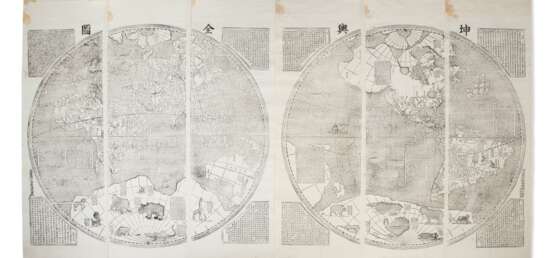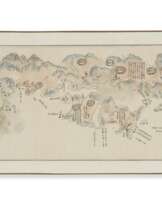ID 627569
Лот 79 | Verbiest's world map
Оценочная стоимость
$ 15 000 – 25 000
Fascinating restrike from the 19th century Korean woodblocks of Ferdinand Verbiest's influential world map. Originally published in Beijing in 1674, Ferdinand Verbiest’s world map was produced during his mission to China at the behest of the Second Qing Emperor Kangxi. The map drew on sources both from the west and China, applying the method of stereographic projection to draw the east and west hemispheres (Tam). The principal western sources appear to be Blaeu’s world map of 1648 and Gesner’s Historia animalium, which supplied the models for the animals which are shown in the uncharted southern regions. The original manuscript copy is lost, but three extant printed copies consisting of eight vertical scrolls, with the six in the middle drawing the east and west hemispheres flanked by two scrolls with four cartouches on each, preserves the original composition and detail. These three copies are in the collection of the National Palace Museum, Taipei, the Nanjing Museum and the Hebei University. A colored manuscript version of the map is in the collection of the National Library of Australia; this version was thought to be painted for Emperor Kangxi’s inspection. A third version of the map was repainted by Michel Benoist for Emperor Qianlong. The fourth and the most popular version was the woodblock version printed in Guangdong in 1856, reprinted in Seoul, Korea in 1860 and c.1931 (Ma and Zhang). The present lot belongs to the last category. The Seoul reprints of 1860 and c.1931, which are virtually identical, differing from the original with the addition of a new imprint in Chinese, and differently-shaped spandrels. “Flemish scientist Ferdinand Verbiest joined the Jesuit order in 1641; he traveled to Macao in 1659, where he studied Chinese and Confucian classics and took his final religious vows. He was a polymath best known for this Chinese world map, a revised Chinese calendar, and astronomical works in Chinese and Latin. Notwithstanding his status as a foreigner he developed an unusually close relationship with the Kangxi emperor, who conferred mandarin rank on Verbiest and granted him an official funeral. For the emperor, cartography was a significant expression of his control over the regions under imperial domain. Verbiest's world map drew from contemporary Dutch maps and Chinese sources, but it presented the world in a format appropriate to a Chinese audience. Counter to Western mapmaking traditions that focused on Europe, this map deferred to local conventions by placing China at the symbolic center, surrounded by countries that could be construed as tributary states.” Comparable examples of this map, also with only six instead of eight scrolls, can be found in three institutions in Japan: Waseda University Library, Izumi City Kuboso Memorial Museum of Arts, and Tokyo Keizai Universit Institutional Repository. The present lot was once in the collection of the Keijō Imperial University, a Japanese university which existed in 1924-1946, the period of Japanese occupation of Korea (Tam). Its location is in modern-day Seoul, South Korea. References: Kwong-Lim Tam, Cong Fangyuan dao Jingwei: Xianggang yu Huanan Lishi Ditu Zhencang [From Circular and Square Shapes to Meridian and Parallel Lines: Collected Treasures of Historical Maps of Hong Kong and South China] (2010), pp. 53, pl. 22; Xiujuan Ma and Lan Zhang, “Studies on Different Versions of Ferdinand Verbiest’s Kunyu Quantu and Their Influence,” Keji Feng, no. 17 (2020), pp. 224; Marcia Reed and Paola Demattè, China on Paper: European and Chinese Works from the Late Sixteenth to the Early Nineteenth Century (2007).
Very large woodcut world map, ink printed on paper, composed of six separate sheets (of eight; versions exist with two side sheets of cartouches), each approximately 1810 x 575 mm, forming an overall map of 1810 x 3456 mm or roughly six by 11 feet. Two hemispheres with Eurasia on the left and the Americas on the right, title along the top margin, date of reprint at the lower left part of the scroll on the extreme left side. The map captioned in Chinese and decorated with mythical animals, sea monsters and geographical texts. (Light yellow stains on the upper left corner of each scroll and along the left margins, some minor wear and wormholes, soiling on the uppermost portion of the third scroll to the left). Provenance: Keijō Imperial University, 1924-1946 (reputed).
Please note that this lot is subject to an import tariff. If the buyer instructs Christie’s to arrange shipping of the lot to a foreign address, the buyer will not be required to pay the import tariff. If the buyer instructs Christie’s to arrange shipping of the lot to a domestic address, if the buyer collects the property in person, or if the buyer arranges their own shipping (whether domestically or internationally), the buyer will be required to pay the import tariff. Please contact Post Sale Services on +1 212 636 2650 prior to bidding for more information.
| Автор: | Уильям Шекспир (1564 - 1616) |
|---|---|
| Техника исполнения: | Карандаш |
| Автор: | Уильям Шекспир (1564 - 1616) |
|---|---|
| Техника исполнения: | Карандаш |
| Адрес торгов |
CHRISTIE'S 8 King Street, St. James's SW1Y 6QT London Великобритания | |
|---|---|---|
| Предосмотр |
| |
| Телефон | +44 (0)20 7839 9060 | |
| Комиссия | see on Website | |
| Условия использования | Условия использования |












